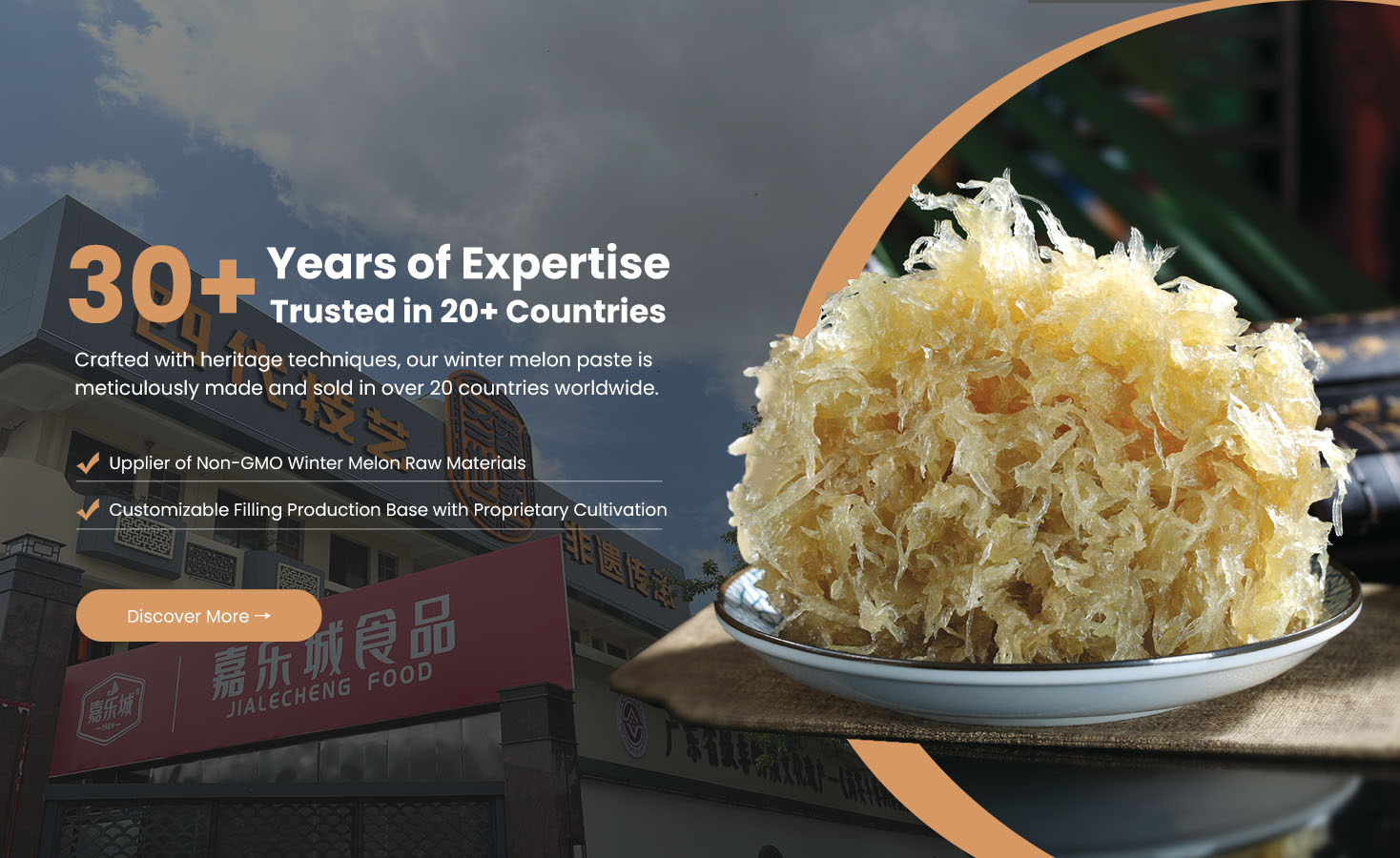How Do You Control Moisture And Viscosity in Winter Melon Filling?
The quality of Winter Melon Filling depends largely on two physical properties — moisture and viscosity. These determine how smooth, elastic, and stable the paste will be during baking and storage.
If moisture is too high, the filling becomes loose, sticky, and prone to spoilage. If too low, it turns hard or grainy. Likewise, if viscosity isn’t balanced, the paste may either flow uncontrollably or become too dense to handle.
Professional manufacturers like Jialecheng Foods use precise ingredient ratios, heat control, and vacuum technology to stabilize these parameters — achieving a consistent, glossy texture that remains soft and pliable after baking.
Below is a detailed explanation of how moisture and viscosity are scientifically controlled in industrial winter melon paste production.
1. Understanding the Relationship Between Moisture and Viscosity
In winter melon paste, moisture and viscosity are closely linked.
Moisture determines the paste’s softness, mouthfeel, and shelf life.
Viscosity measures its flow resistance — how thick or spreadable it is.
| Property | Too Low | Ideal Range | Too High |
|---|---|---|---|
| Moisture | Hard, dry, cracks easily | 18–22% | Watery, sticky, unstable |
| Viscosity | Thick, difficult to spread | 25,000–35,000 cP | Thin, syrupy, weak body |
A balance between water content, sugar concentration, and heat exposure gives the paste its signature glossy, chewy texture.
2. Raw Material Preparation: Setting the Foundation
The process starts with the water content of the raw winter melon. Fresh melons contain up to 90% water, which must be carefully reduced during cooking.
Control points:
Blanching step removes excess surface moisture.
Draining and weighing before cooking ensures consistent input weight.
Sampling of melon cubes for moisture baseline using a digital moisture analyzer.
| Parameter | Target Value |
|---|---|
| Fresh melon moisture | 88–92% |
| Post-blanching moisture | 80–85% |
| Input weight per batch | Constant (±0.5%) |
This guarantees uniform starting conditions before the sugar infusion stage.
3. Sugar Concentration and Ingredient Ratios
Sugar and maltose directly affect both water retention and viscosity in the paste.
Sugar binds with water molecules, reducing free water and thickening the paste.
Maltose or glucose syrup increases elasticity and prevents crystallization.
Vegetable oil adds smoothness and reduces water evaporation rate during cooking.
Typical ratio (by weight):
Winter melon: 55–60%
Sugar: 30–35%
Maltose/glucose syrup: 5–10%
Oil: 3–5%
| Ingredient | Role in Moisture Control | Role in Viscosity Control |
|---|---|---|
| Sugar | Binds free water | Creates syrup thickness |
| Maltose | Retains moisture | Adds elasticity, prevents crystallization |
| Oil | Reduces drying | Improves smooth texture |
4. Controlled Cooking and Evaporation
During the simmering stage, moisture reduction and viscosity increase occur simultaneously. Jialecheng uses steam-jacketed vacuum kettles for precise control.
Process settings:
Initial temperature: 95–100°C (melting sugar and softening melon)
Mid-stage: 100–105°C (moisture reduction phase)
Final stage: 105–110°C (thickening and caramelization)
Continuous stirring keeps the mixture from sticking or burning, while in-line viscosity sensors and refractometers monitor sugar concentration in real time.
| Parameter | Target | Purpose |
|---|---|---|
| Moisture level | ↓ from 80% → 25–30% | Pre-concentration before vacuum stage |
| Brix (sweetness) | 60–65° | Controls thickness |
| Stirring speed | 30–40 rpm | Uniform heating and evaporation |
5. Vacuum Concentration for Final Moisture Control
Once the mixture reaches pre-thickened consistency, it is transferred to a vacuum concentrator.
Why vacuum processing matters:
Lowers boiling point to 70–80°C, allowing water to evaporate gently.
Preserves the melon’s natural aroma and light color.
Prevents sugar caramelization, which can make paste grainy.
Target final moisture: 18–22%
Final viscosity: 25,000–35,000 cP
| Variable | Under Vacuum | Benefit |
|---|---|---|
| Temperature | ≤80°C | Prevents overcooking |
| Pressure | –0.09 MPa | Accelerates moisture removal |
| Time | 20–30 minutes | Achieves uniform texture |
6. Measuring and Adjusting Viscosity
Viscosity is checked during and after cooking using a Brookfield rheometer.
If viscosity is too high, small amounts of oil or syrup are added to loosen the structure.
If too low, further water evaporation continues under vacuum until the target range is reached.
Fine-tuning adjustments:
Temperature correction: Cooling naturally increases viscosity.
Sugar balance: Slight increase in maltose enhances flowability without increasing sweetness.
| Condition | Adjustment |
|---|---|
| Too thick (high viscosity) | Add 1–2% maltose syrup or oil |
| Too thin (low viscosity) | Continue vacuum evaporation |
| Grainy texture | Reduce temperature, extend stirring time |
7. Cooling and Deaeration
Once the desired moisture and viscosity are reached, the paste is cooled to below 40°C in a closed cooling system.
Deaeration removes trapped air bubbles that can affect density and packaging stability.
The paste thickens slightly as it cools, stabilizing at final viscosity.
| Step | Equipment | Purpose |
|---|---|---|
| Cooling | Closed-loop water cooler | Prevent condensation |
| Deaeration | Vacuum chamber | Prevent oxidation and bubbles |
8. Moisture Retention During Packaging
To prevent post-production moisture change:
The paste is packed while still warm (35–40°C) into vacuum-sealed bags.
Low-oxygen environment prevents microbial growth and moisture migration.
Each batch is weighed, sealed, and coded for traceability.
| Packaging Type | Moisture Stability | Storage Duration |
|---|---|---|
| Vacuum-sealed bag | Excellent | 6–12 months |
| Non-vacuum (short-term use) | Moderate | 1–3 months |
9. Laboratory Quality Testing
Each batch undergoes strict testing before shipment:
| Test | Equipment | Target |
|---|---|---|
| Moisture content | Infrared analyzer | 18–22% |
| Viscosity | Brookfield rheometer | 25,000–35,000 cP |
| Brix value | Digital refractometer | 68–72° |
| Color | Colorimeter (Lab*) | Light golden consistency |
| Texture | Penetrometer test | Soft but firm surface |
Results are recorded in Jialecheng’s digital quality management system (QMS) for full production traceability.
10. Summary of Moisture and Viscosity Control
| Control Stage | Key Method | Outcome |
|---|---|---|
| Raw material prep | Moisture baseline analysis | Consistent starting point |
| Cooking phase | Temperature + stirring control | Progressive evaporation |
| Sugar ratio | Binds water and builds body | Stable sweetness and texture |
| Vacuum concentration | Precise moisture removal | Smooth, glossy finish |
| Cooling and deaeration | Stabilizes density | Prevents air and oxidation |
| Packaging | Vacuum sealing | Maintains moisture balance during storage |
11. Conclusion
Controlling moisture and viscosity in Winter Melon Filling requires a combination of science, precision, and experience. By regulating temperature, evaporation rate, and sugar balance, manufacturers like Jialecheng Foods achieve a paste that is:
Moist but not watery
Smooth and glossy
Stable under baking heat
Consistent in every batch
This meticulous control system allows Jialecheng to supply export-grade, bake-stable winter melon paste that meets the strict standards of professional pastry manufacturers around the world.




